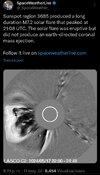SOLAR CYCLE 25 ACTIVITY REPORT MAY 24_2024
Solar activity has been at high levels for the past 24 hours. The largest solar event of the period was a M4 event observed at 0216 UTC from Region 3679 (S09W73). See previous report.
In addition AR3679 produced the following M-class flares
● M1.7 at 04:29 UTC the flare generated a Minor R1 radio blackout over Asia
● M2.5 at 13:20 UTC the flare generated a Minor R1 radio blackout over Atlantic Ocean.
On the other hand AR3689 produced a M1 at 15:58 UTC the flare generated a Minor R1 radio blackout over Western Atlantic Ocean
The total number of sunspots has increased to 130 of which 60 of them are grouped into 7 active regions as follows:
a (alpha) B (beta) y (gamma) d (delta)
AR3674 AR3682 & AR3688 are gone.
AR3679 has developed a beta-gamma-delta magnetic field that harbors energy for strong X-class flares. AR3684 & AR3685 have beta-gamma magnetic field that harbors energy for M-class flares. All remaining regions have stable magnetic fields
NOAA's forecast for the next 24 hours: 99% chance of C flares, 60% chance of M flares and 10% chance of X flares.
● Auroral Activity
The geomagnetic field has been at quiet to unsettled levels for the past 24 hours. On May 23, Solar wind speed reached a peak of 419 km/s at 03:07 UTC. Total IMF reached 8 nT at 19:40 UTC.
Aurora Oval Bz: -5.51 nT South
● Current Conditions at 04:53 UTC on May 24
Geomagnetic activity is at Kp2 (quiet) The solar wind has a normal speed of 353 km/s pointing south with negative Bz value of -5.51 nT which offers good conditions for aurora sightings at high latitudes. Thermosphere Climate Index (TCI) continues to be hot.
ROCKS AND SOIL ELECTRIFIED BY THE SUPERSTORM: Across the USA on May 10th and 11th, sky watchers marveled at bright displays of aurora borealis during the biggest geomagnetic storm in decades. Little did they know, something was also happening underfoot.
Strong electrical currents were surging through rocks and soil. The biggest voltages along the US eastern seaboard and in the Midwest were as much as 10,000 times normal. A map from NOAA and the US Geological Survey shows some of the 'hot spots' during the early hours of May 11th:

Back in March 1989, voltages only a little stronger than the ones shown above brought down the entire Hydro-Québec power system. The resulting
Great Québec Blackout plunged millions of Canadians into darkness.
This time, however, power grids stayed up. "We haven't heard of any serious problems so far," reports Christopher Balch of NOAA's Space Weather Prediction Center. SpaceWeather.com
On May 23 Solar activity is likely to be moderate with a slight chance for X-class flares while the geomagnetic field is expected to be quiet to active levels.
▪︎ Geospace quiet (Kp2)
▪Solar wind speed record: 353 km/sec (Normal speed)
▪︎ density: 3 p/cm³ (low density)
▪︎ Interplanetary Magnetic Field (IMF)
Bt: 7 nT
▪︎ X-ray Solar Flare : C5 2259 UT May23
▪︎ Thermosphere Climate Index
today: HOT
▪︎ Neutron Counts today: -6.6% (Low)
▪︎ Sunspot number: 130 (SN 120 May 23)
▪︎ Spotless Days 2023 total: 0 days (0%)
▪︎ There are no significant equatorial coronal holes on the Earthside of the sun
.................
SpaceWeatherlive.com
SpaceWeather.com





